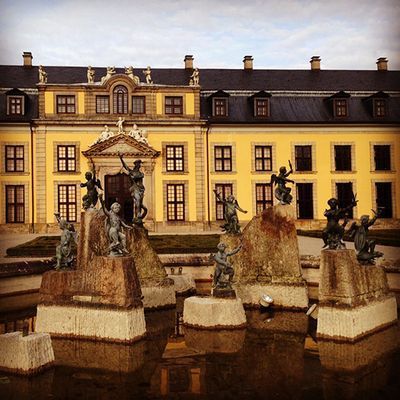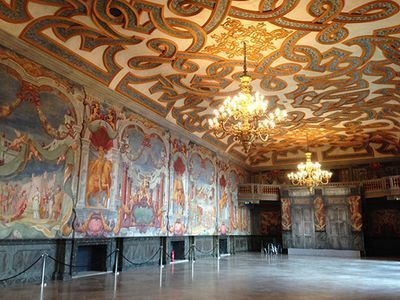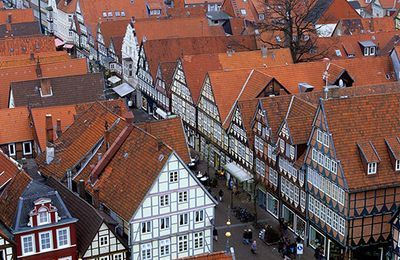Get Georgian: part 2 – Hanover hangouts
By MIKA ROSS-SOUTHALL
Back to the Georgian season, taking place in London and Hanover this year (see part 1 from last week): The Hanoverians on Britain’s Throne 1714–1837, the exhibition at the Lower Saxony State Museum Hanover, begins with two coins. “Rosssprung” (1714) shows a heroic, Hanoverian horse (“ross”) leaping across the Channel from Germany to Britain, marking the accession of George I. The coin next to it, minted over a century later at the end of the Georgian reign, depicts a rather more sedate steed plodding its way back to Germany. British humour from the German curators of the exhibition, perhaps.
And that’s not all we share – at first, the information panels, paintings and objects on display (similar to Queen Caroline’s fascinating closet of curiosities at Kensington Palace) are colour coded to indicate two separate nations (red for Hanover, blue for Britain). But the colours increasingly overlap as we progress through the eighteenth century. Key figures, other than the Kings and Queens, are featured, such as Jonathan Swift (I was surprised to hear from one of the curators that many Germans only know of Swift as a children’s writer), Handel, Johann Christian Bach (the eleventh son of Johann Sebastian, and the organizer, with Carl Friedrich Abel, of the Bach-Abel concerts in England), Captain James Cook and Jane Austen (who dedicated Emma to George IV). Pieces from the extensive art collection founded by George II’s illegitimate son, the Count of Wallmoden, are reunited since 1818, on loan from galleries including the Metropolitan Museum of Art in New York and Museo Nacional del Prado in Madrid.
One of the stand-out objects, for me, is a letter written in Burmese script on pure gold, decorated with twenty-four rubies and contained in an elephant-ivory case sent from King Alungphaya of Burma to George II on May 7, 1756 (it took almost two years to travel from Burma to London). The Burmese King proposed a trade relationship: "kindest greetings to the English King who rules over the English capital . . . . When close friendship prevails between Kings of different countries, they can be helpful to the needs of each other which we are eager to fulfil" (this content was deciphered in 2011 after three years of examination). But George II wasn’t interested and sent it to his treasure store in Hanover.
Herrenhausen Palace, the summer residence of the eighteenth-century Hanoverians, has been rebuilt by Volkswagen after being bombed by the RAF during the Second World War. The exhibition it now houses looks at the period leading up to George I’s accession; in particular, at his mother, Electress Sophia of the Palatinate. She died in the palace’s baroque gardens during a thunderstorm, and there’s a memorial sculpture to mark the spot, alongside a fountain (one of the tallest in Europe) designed by Gottfried Leibniz and the mausoleum where George I is buried.
Ornate baroque architecture, frescoes and spiralled stucco ceilings of the palace’s original orangery (see photo above) and outdoor theatre provide the back-drop for the KunstFestSpiele Herrenhausen; a summer festival, that aims to showcase unconventional interactions between art forms. In 2011, Vivienne Westwood provided grunge-rococo costumes for the director Ludger Engels and the dramatist Andri Hardmeier’s bold take on Handel’s opera Semele, with catwalk-type staging.
Just outside the city of Hanover sits Celle Castle, the oldest residence of George I's ancestors. An exhibition on the Hanoverian dynasty is happening here, too. The surrounding town is pretty, with colourful, half-timbered houses (a “Latin school” from 1604 is still in use) and cobbled streets. At the entrance of a public park, I also came across “öffentlichen Bücherschrank”, a cabinet of free books – I’ve noticed them in Berlin before – and I saw a man with a stack, sat on a nearby bench. If only the Hanoverians had brought this idea with them to London, all those years ago . . . .
Peter Stothard's Blog
- Peter Stothard's profile
- 30 followers






